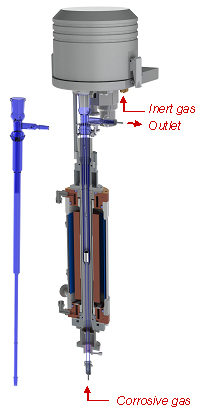| It may occur that standard instruments are limited in terms of application because of temperature, pressure ranges available, because of the lack of chemical compatibility of some materials against the atmospheres to be tested, or because they cannot achieve very specific functions. Coupling analytical methods can be a way to draw more information from a single sample to understand more into depth its chemical / physical behavior, or to obtain simultaneous data under the exact same conditions. But it requires the evolution of standard analyzers so that they can physically fit and that they are not disturbed by their simultaneous operation. For such reasons the SETARAM standard thermal analyzers can be customized… |
|
…for specific sample and process conditions
SETSYS Evolution schematics Thermogravimetry is a common technique for the characterization of the thermal stability of materials, to understand their degradation process or to analyze their composition. Some materials like fluorides or oxyfluorides – which have interesting optical properties – release significant amounts of corrosive gases during their thermal stability testing. To fit to a customer request, our standard SETSYS Evolution TGA was modified in order to stand the release of fluorine and hydrofluoric acid (up to 20% of initial sample mass). A further challenge was that the users wanted to test the material mass uptake under a flow of a gas containing up to 10% in mass of fluorine. For more information on the SETARAM achievements in that field, click here and download technical note TN701 in our application library |
|
…for multiple simultaneous measurements
Schematics of the setup after microbalance integration, A good way to determine the adsorbed species on the surface of a catalyst is infrared spectroscopy, while thermogravimetry is a good tool for the quantification of those adsorbed species. The Laboratory of Catalysis and Spectrochemistry of Caen (France) approached us to modify a standard microbalance in order to fit it with operando IR spectroscopy. The goal was to develop a TG-IR coupling with an IR beam directly oriented to the surface of the catalyst being weighed by the balance. |




